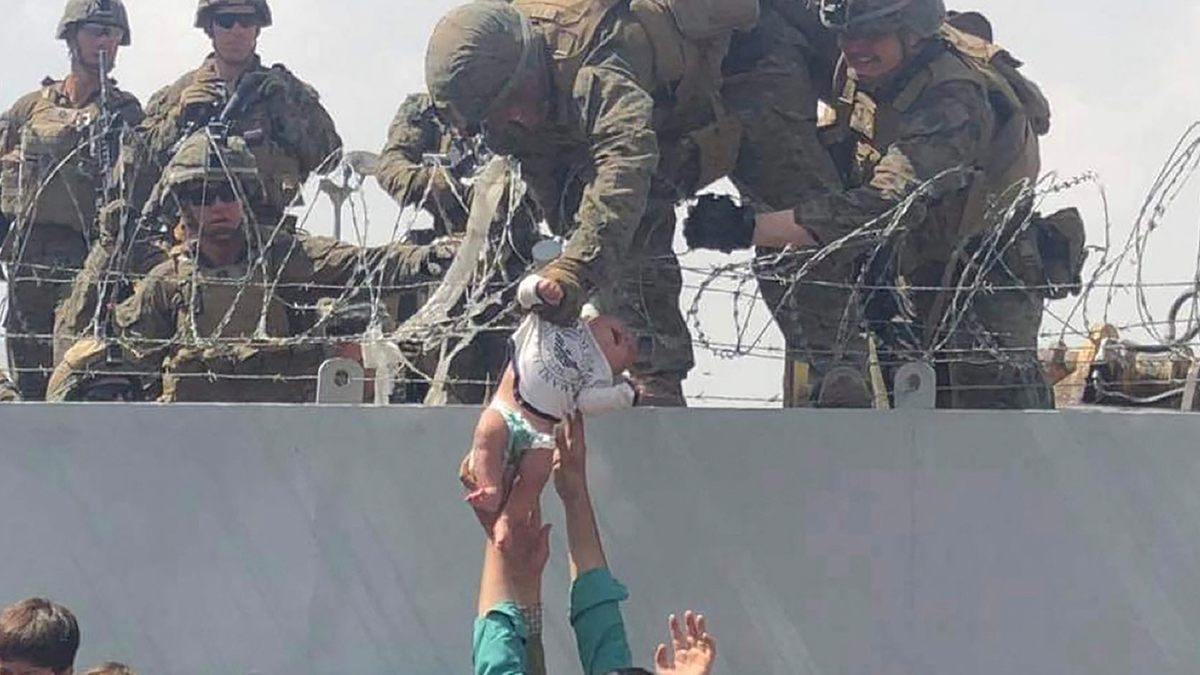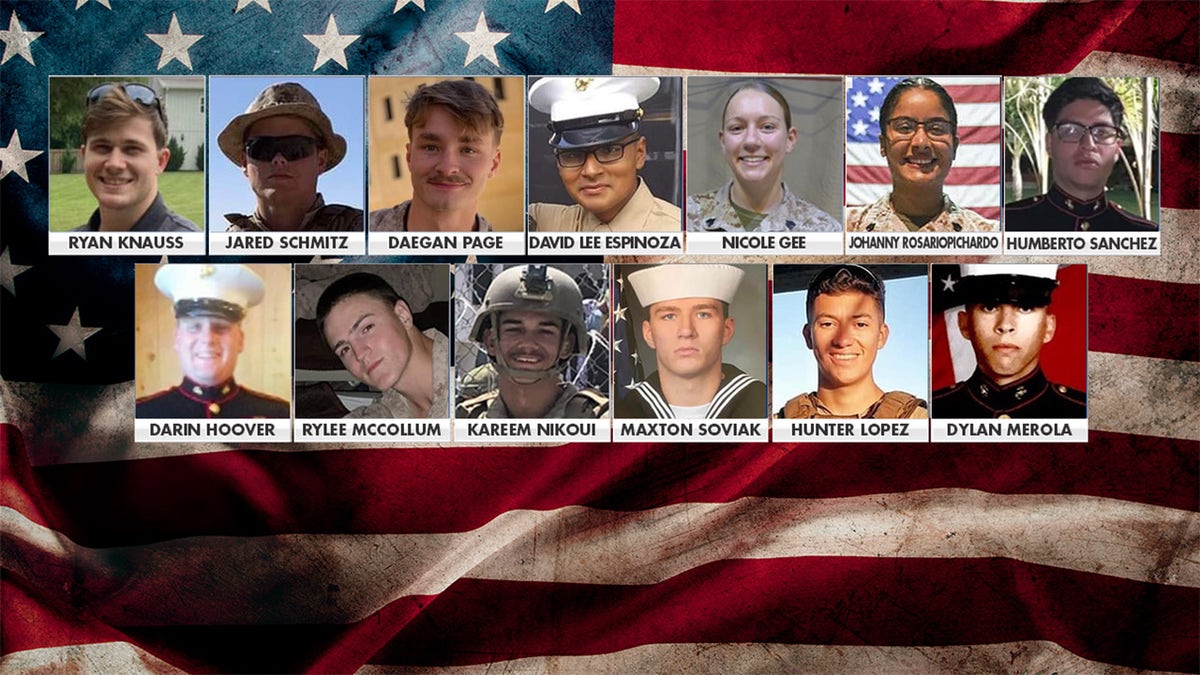Fox News Flash top headlines for February 8
Fox News Flash top headlines are here. Check out what's clicking on Foxnews.com.
A 2,000-page Army investigation found that senior military officials were frustrated by the inability of the White House and State Department to recognize the imminent security threat that led to the chaotic withdrawal from Afghanistan.
The investigation, first obtained by the Washington Post Tuesday through a Freedom of Information Act request, was launched in response to the deadly events of Aug. 26, when 13 U.S. service members and roughly 170 Afghan civilians were killed by a suicide bomb attack.
Fox News confirmed with two senior U.S. defense officials that the details outlined in the Army’s report were accurate.
PENTAGON SAYS AFGHAN TERROR ATTACK THAT KILLED 13 US SERVICE MEMBERS WAS ‘NOT PREVENTABLE’

U.S. Marines with Special Purpose Marine Air-Ground Task Force - Crisis Response - Central Command, provide assistance at an Evacuation Control Checkpoint (ECC) during an evacuation at Hamid Karzai International Airport, Kabul, Afghanistan, Aug. 21. (U.S. Marine Corps photo by Staff Sgt. Victor Mancilla)
Sworn testimony by military officials involved in the withdrawal described fundamental differences between the Department of Defense (DOD) and the State Department that may have placed the service members tasked with securing the Hamid Karzai International Airport in greater danger.
The top U.S commander on the ground during the evacuation, Navy Rear Adm. Peter Vasely, told Army investigators that service members would have been "much better prepared to conduct a more orderly" evacuation "if policymakers had paid attention to the indicators of what was happening on the ground."
According to the report, Vasely argued the messy withdrawal was rooted in the administration’s inability to understand the determination by the Taliban to completely take over Afghanistan.
The U.S reached a deal under the Trump administration with the Taliban to remove all troops from Afghanistan by May 1, 2021. The Biden administration then pushed this date by four months and said the U.S. withdrawal be completed by Sept. 11, 2021 — the 20th anniversary of the terrorist attacks that prompted the U.S.’s longest war.
The State Department, DOD and National Security Council (NSC) began planning for a potential mass evacuation that summer but did not predict Kabul would fall as fast as it did. The U.S. military had complained privately for months that the State Department and U.S. Embassy were not moving fast enough to approve Special Immigrant Visas (SIV) and begin evacuating Afghan allies.
On Tuesday a State Department spokesperson told Fox News that both departments "coordinated closely on necessary planning and arrangements to execute the President’s decision to withdraw U.S. troops from Afghanistan."
"Early in the Biden administration, we began significantly accelerating SIV processing," the spokesman said, adding that the departments also worked with Congress to pass legislation to ease flexibility in quickly relocating refugees.
"As we prepared to leave Afghanistan, we pre-positioned military assets in the region that enabled us, under extraordinarily challenging circumstances, to execute one of the largest airlifts in history," the spokesman said.
Marine Corps Brig. Gen. Farrell Sullivan, who helped with planning and oversaw the Marines sent to Kabul to help with the evacuation, pointed to the disparity in the number of evacuees expected and the reality on the ground.
Sullivan told investigators it was originally thought that roughly 6,000 Afghan paramilitary units and their families assisting with the evacuation would need to be moved out of the country, but the number ended up being closer to 38,800.
It was realized that commercial airlines would be needed to assist with the evacuation of roughly 124,000 Americans, Afghan allies and their families fleeing Taliban rule — 80,000 of which arrived in the U.S. after first being vetted.
KABUL AIRPORT ABBEY GATE EXPLOSION WAS SINGLE BLAST, NO FOLLOW-UP ENEMY GUNFIRE: PENTAGON

This image made available to AFP on August 20, 2021 by Human Rights Activist Omar Haidari, shows a US Marine grabbing an infant over a fence of barbed wire during an evacuation at Hamid Karzai International Airport in Kabul on August 19, 2021. (Courtesy of Omar Haidiri/AFP via Getty Images)
Kabul fell to the Taliban on Aug. 15.
Sullivan in mid-July called for supplies to be sent to the Kabul airport in preparation for a mass evacuation, but his efforts were thwarted.
The top Marine was not permitted to discuss the possibility of a mass-evacuation with anyone other than British officials the report noted.
Additionally, disagreements over when to evacuate the U.S. embassy in Kabul reportedly lasted for months.
Sullivan told investigators that trying to collaborate with the embassy in Kabul on an evacuation plan was "like pulling teeth." But by early August, the embassy "became more collaborative."
Upon taking up his post in July, Vasely was warned by departing four-star commander Army Gen. Austin "Scott" Miller that he would face pushback from senior embassy officials.
Acting U.S. ambassador to Afghanistan Ross Wilson contested the idea of evacuating the embassy and questioned how the U.S. would maintain influence in the region.
According to the Washington Post, whose reporters scoured the raw transcripts of 2,000-pages of interviews, Vasely was told by embassy staff that he should provide data to those close to the ambassador to show the growing threat of a Taliban seizure "so it could be sold as a collective approach and not a power grab by DOD" — showing just how territorial the withdrawal decisions had become in those final days and weeks of the war.
By Aug. 12, Secretary of State Antony Blinken and White House national security adviser Jake Sullivan reportedly instructed Wilson to get a move on in a call, Vasely told investigators.
An unidentified official on the NSC — which serves as the principal forum on security and foreign policy issues for the president — told officials during an Aug. 6 meeting that carrying out an evacuation would signal "we have failed."
"In my opinion, the NSC was not seriously planning for an evacuation," Sullivan told investigators.
White House press secretary Jen Psaki pushed back on this during questioning by reporters Tuesday and said that though there "wasn't an anticipation that the Afghan National Security Forces would fall as they did or as quickly as they did" the White House still planned for a "range of contingencies."
By Aug. 14, one day before the collapse of the Afghan government, the Navy Rear Adm. Vasely expressed concern that the Afghan government would not survive the Taliban threat.
U.S. forces conducted 10 airstrikes 10 miles south of the capital and killed roughly 100 fighters — but it failed to stop the insurgent group.

U.S. Marines assigned to 24th Marine Expeditionary Unit escorts evacuees during an evacuation at Hamid Karzai International Airport, Afghanistan, Aug. 18. (U.S. Marine Corps photo by Lance Cpl. Nicholas Guevara)
UN: MORE THAN 100 FORMER AFGHAN TROOPS, OFFICIALS KILLED SINCE TALIBAN TAKEOVER
"We were killing them in bunches, destroying tactical vehicles, and they kept coming," Vasely told investigators.
On Aug. 15, military service members were allegedly going from room to room in the Kabul embassy to hurry up staffers, an Army officer from the 10th Mountain Division said.
The Army official told investigators that some embassy personnel were "intoxicated and cowering in rooms," while others were "operating like it was day-to-day operations with absolutely no sense of urgency or recognition of the situation."
A State Department spokesperson flatly rejected the accusations and told Fox News that "a senior official from Embassy Kabul refute[d] these characterizations outright."
"Not only are the wrong, they are insulting," the spokesman continued. "And were there any truth to these allegations, we presumably would not be learning of them nearly six months after the fact."
Principal Deputy Spokesperson Jalina Porter further condemned the allegation and told reporters Tuesday, "Cherry-picked comments do not reflect the months of work that were already underway or the whole picture of what the U.S. diplomats undertook to facilitate the evacuation."
Porter also said embassy personnel "demonstrated immense bravery" during the evacuation and "put their lives at risk, standing shoulder to shoulder with our armed forces at gates to the airport, and in the end helping 124,000 Americans, foreigners, Afghan allies and their families leave Kabul."
The evacuation that ensued in the days following left U.S. soldiers overwhelmed by the sheer number of evacuees attempting to gain access to the airport and forced the U.S. to cut a new deal with the Taliban.
Army Maj. Gen. Christopher Donahue, who arrived at the scene after the collapse of Kabul and oversaw security at the airfield, described tense negotiations with the Taliban.
"We told them that we would control the gates and they would push people out," the report noted. "We expressed that they will comply, because if they fight us on this we would be able to kill more of them than they would ever hope to kill of us. After that their tone changed."
Service members told investigators they were concerned the crowd would overpower them by breaking through a gate and causing a riot.
Roughly 40-50 people were detained each night for jumping fences to get into the airport, and at least four Afghans were crushed to death by the pushing crowds.
In addition to the 13 U.S. service members that were killed, another 45 were wounded in the Aug. 26 blast, some with brain injuries that later surfaced.

The 13 US service members who were killed in terrorists blasts outside Kabul's airport. (Top from left to right: Family Handout, Facebook/ Nick Schroer, Family Handout, City of Rio Bravo, @Nicole_Gee_/Instagram, Naval Amphibious Force, Facebook / Bottom left to right: Facebook, Facebook, Family Handout, U.S. Navy, Facebook, GoFundMe.com)
CLICK HERE TO GET THE FOX NEWS APP
Sullivan said lasting consequences would likely affect the soldiers involved in the evacuation.
"I am not particularly soft, as adversity comes with our duties," Sullivan told investigators. "But this was an extremely challenging situation."
The Department of Defense told Fox News it is "proud" of the coordinated effort it undertook with the State Department to facilitate the withdrawal and evacuation from Afghanistan.
"Throughout this evacuation and in the months following — as we welcomed Afghans to begin their new lives in the United States, the U.S. government has led a coordinated and cohesive interagency effort," deputy Pentagon press secretary Todd Breasseale said. "The Department of Defense is proud to have worked shoulder to shoulder with our partners at the Departments of State and Homeland Security, the intelligence community, and others in support of this historic mission."





















